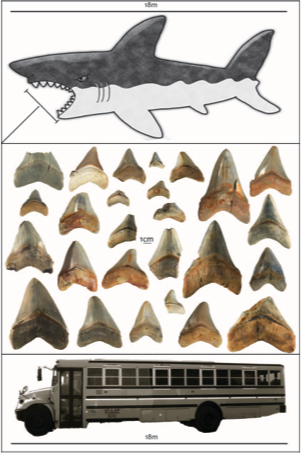I’m at the Ecological Society of America meetings this week, so invited grad students Meghan Balk and Catalina Pimiento to write a guest post to coincide with Shark Week. Little did I know that this post would be so timely, with Discovery’s disastrous fake documentary on Megalodon! I hope you enjoy reading about these very-much-extinct apex predators as much as I did.
By Meghan Balk and Catalina Pimiento
We’ve all seen the clips on Shark Week about the biggest shark that ever lived, Megalodon, which was ~3 times the length of the great white shark, and ~10 times the mass. But, how much do we really know about this extinct, mysterious creature? What exactly did it eat? Where did it live? Why did it go extinct? These are questions that we have been trying to tackle.
When did the shark live? Records of the shark are from about the middle Miocene to the early Pliocene (16 to 2 million years ago).
What were the oceans like when this marine predator was alive? The oceans were in general warmer, and less stratified. Geologically, this period was very similar to modern. However throughout the Miocene, the Isthmus of Panama started forming, culminating with the closure of the Central American Seaway during the Pliocene (around 3 million years ago), shutting off any exchange between the Atlantic and Pacific Oceans. Around the same time, we see great changes in marine communities: marine mammal diversity changes drastically. In addition, Orca (killer) whales emerged in the fossil record. Being social hunters, it has been suggested that they out-competed Megalodon’s hypothesized solitary hunting style.
Where did the shark live? Megalodon was a cosmopolitan shark; their teeth are found in sediments of the Atlantic, Pacific and Indian Oceans. These fossils are usually associated with coastal environments.
What did it eat? This is a difficult question to answer. We don’t have a time machine, so we will never know for sure. But, there are clever ways to figure out its diet. It is assumed that this mega-tooth shark had to feed on marine mammals. In determining its potential diet, it is important to have a good estimate of body size. We can estimate body size by extrapolating known relationships between tooth height and body length in modern sharks that serve as analogs (like the Great White Shark). By looking at the relationships between body size, metabolic rate, and prey size, we can infer the types of food packages Megalodon had to eat in order to survive.
Why did it go extinct? This is one of the biggest questions of our research. We still don’t know the answer but we are trying to determine patterns in their geographic distribution and body size throughout time to better understand first how it became extinct. Once we reconstruct their way into extinction, we will potentially know not only some of the reasons for its extinction, but also the consequences of loosing one the largest apex predators that ever lived.
Why do we care about an extinct shark? Great sharks today, like Megalodon in the past, are apex predators impacting communities via top down control. However, in many of our oceans, these apex predators are jeopardized in a couple of ways: 1) due to overfishing of their prey, sharks may have to alter their diets or migratory patterns, 2) sharks are also being overfished, possibly creating a change in their demographics: older, larger sharks are gone, which eat different prey than their younger, smaller counterparts. Apex predators play a key role in maintaining the equilibrium of our oceans. The removal (or decline) of sharks may have catastrophic consequences on all trophic levels. So, as we change the oceans, we also trigger cascading effects on entire ecosystems. Understanding the past – how this shark interacted in its community – can aid in making policy for marine systems.
Categories: Explainers Guest Posts Research


I am really fascinated about the megatooth shark. are they extinked?
LikeLike
Sadly, yes. We don’t appear to have had any for a couple million years. You can find their fossils, though!
LikeLike
Wasn’t megalodon more like 20-30 times heavier than a great white if it was 2.5-3.5 times longer ?
10 times heavier only would make a large shark but very slender by comparison.
LikeLike
I know what they ate remember discovery mermaids l
LikeLike
Reblogged this on Mark Solock Blog.
LikeLike